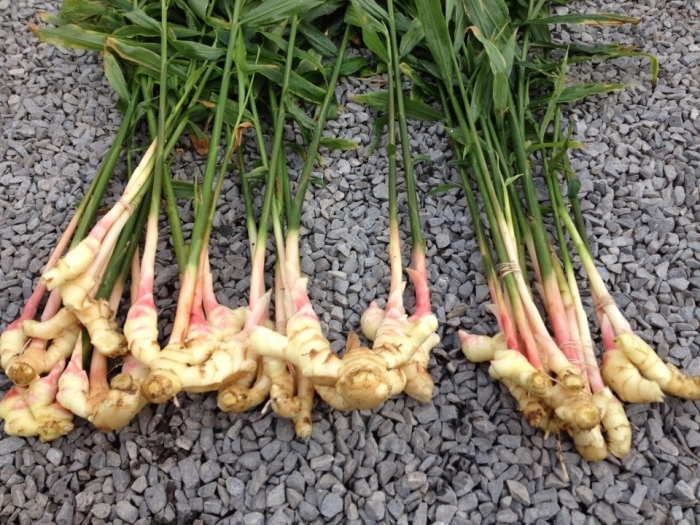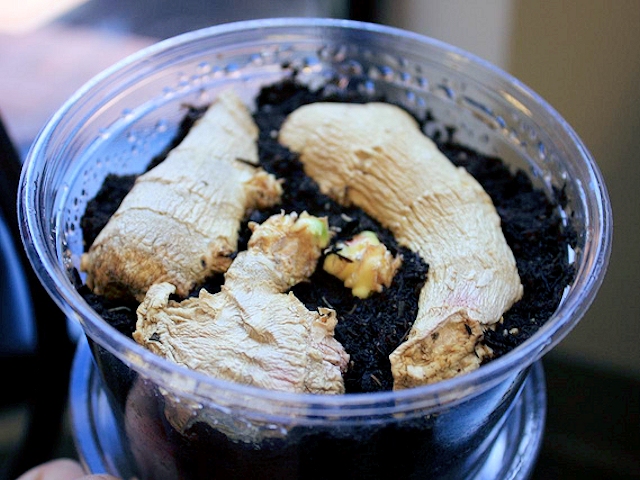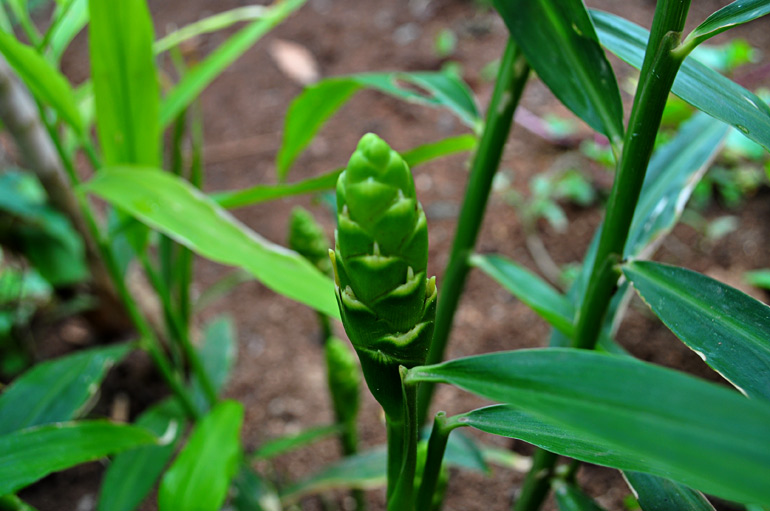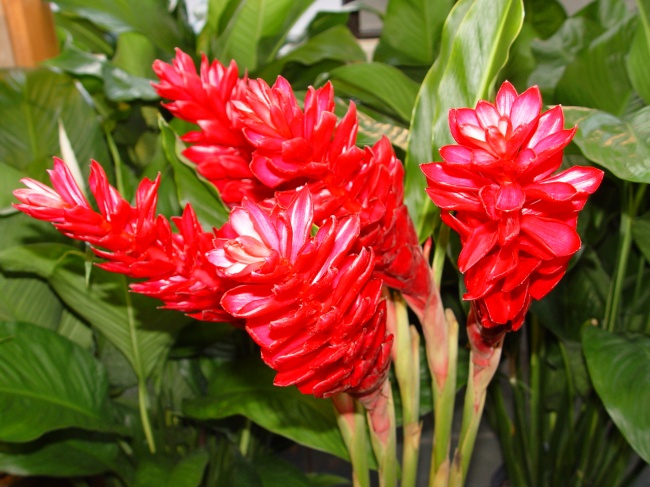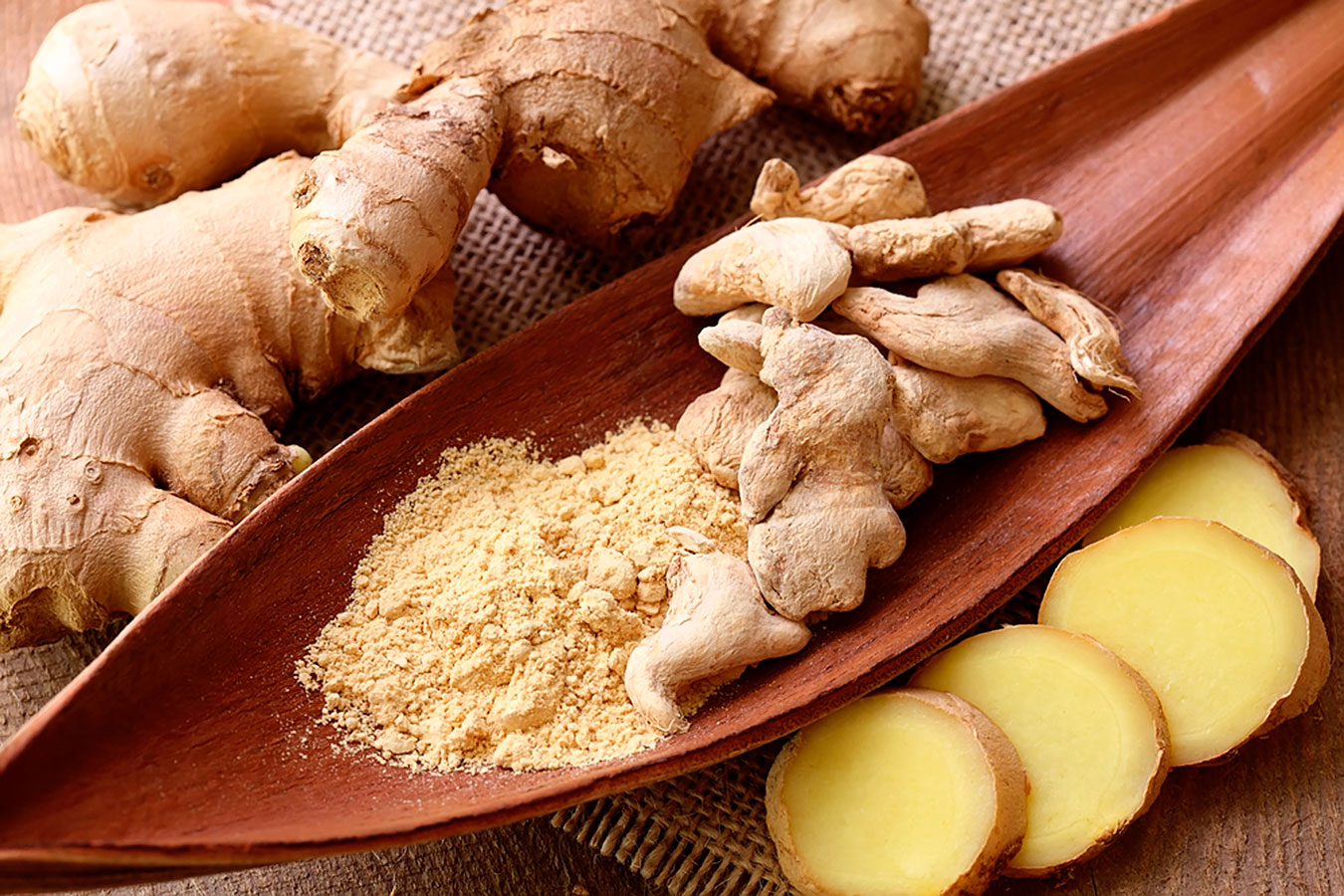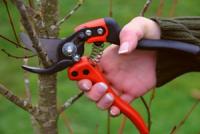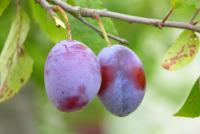Ginger plant. Growing plants in the country. How to plant ginger: features of growing.
Today, ginger root without problems can be purchased. And how to grow ginger from the root at home? Have you never had this question in your mind? It turns out you can. You can on the windowsill, and you can in the garden.
Due to its medicinal qualities and fat burning effect, this healthy spicy tuber has become incredibly popular, by the way, deservedly so.
At home, ginger is planted in winter or early spring. Planting ground should be soft and loose, so that sprouts freely make their way through it. At the initial stage of cultivation, you can feed the soil with potash fertilizers.
Pot for ginger should have a wide bottom, because the growth of the tuber is produced mainly in breadth. At the bottom of the tank you need to pour expanded clay drainage (4-5 cm), and then the soil. You can pre-purchase a special soil for growing vegetable cropsor you can mix earth, turf, deciduous humus and sand in equal parts.
How to plant ginger root?
First you need to choose a quality planting material - smooth and healthy, not overdried root. Since ginger multiplies by dividing the tuber, the planting root must have many buds ("eyes") on its surface. These sprouts somewhat resemble potato "eyes" and perform a similar function.
Choose for planting plump roots, wrinkle-free, with several "fingers", with visible eyes at the end of the "fingers". It would be ideal for these eyes to turn green, but, in general, it is not necessary.
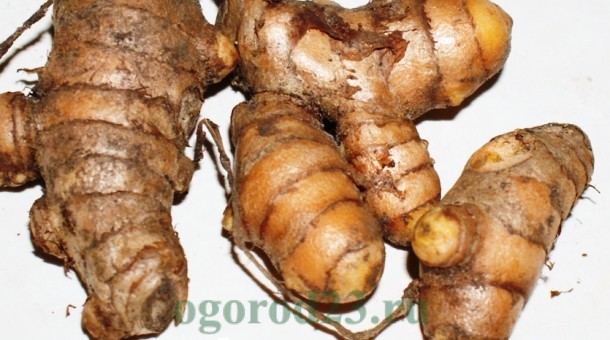
Before you buy ginger root for planting, make sure that it has not been in the freezer.
In order for the kidneys to “wake up” and become more active, you can soak the root in warm water for 3–4 hours and then cut (cut across the bridges) into separate fragments. Some gardeners recommend soaking tubers in a not very strong solution of potassium permanganate. The cut area can be powdered with crushed coal (activated pharmacy or ash).
As mentioned above, the ginger root is planted in early spring.
Ginger prefers partial shade or areas where the sun is from morning till noon. Landing should be protected from wind, the soil is wet and warm - somewhere from 22 ° to 25 ° C.
In the tropics in their homeland, ginger grows in full shade, but, for example, in conditions middle band a shady place may be too cold for him.
Ginger grows slowly, especially outside the tropics. If you are lucky, a sprout may appear in a few days. But usually it takes at least two weeks.
For full maturity, 8-10 months should pass, so by the onset of winter you can already reap the fruits of your own harvest. 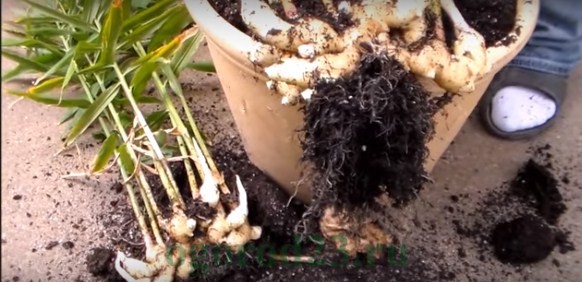 Under natural habitat, ginger is perennial plant, but in the domesticated version it will be one-year.
Under natural habitat, ginger is perennial plant, but in the domesticated version it will be one-year.
Ginger root should be deepened by about 3 cm, while the germs (eyes) should look up. After planting, sprinkle the tubers with soil and pour water over it. It is better to place the pot itself where it will be cool, not more than + 15 ° C, where it will be dry, there will be no access to direct sunlight.
The first shoots appear usually after 12-14 days, before this time you should not overly fill the soil with water (so that the roots do not rot) - it should be a bit damp. 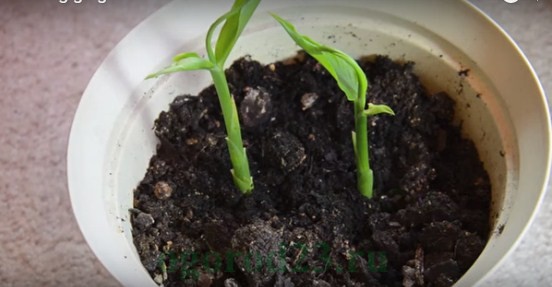
How to grow ginger from the root - care
Caring for the ginger root while growing is regular but moderate watering. It should not be allowed to dry out the soil, as well as too much moisture. During the growing season, ginger can be fertilized with mullein, diluted in water (1 in 10), about 1 time in 3 weeks. After each watering, it is recommended to loosen the upper layer of soil, and if you irrigate the stem from the sprayer every day, the ginger will tell you “thank you”.
Around the end of September, when the stalks and leaves of the plant begin to turn yellow, dry out, reduce the frequency of watering to a minimum, and stop irrigation altogether. 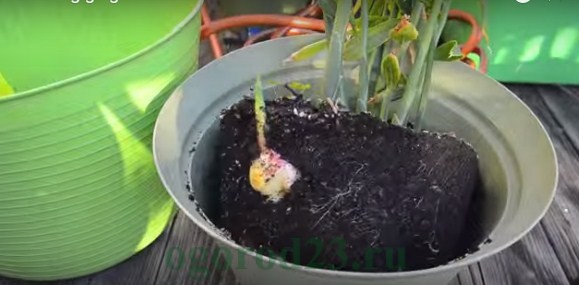 By the time the ground part of the ginger is completely dry, you can dig up the tubers. After extraction from the ground, ginger is cleaned from the remnants of the soil, the adventitious roots are removed, dried in an open sunny place for several days.
By the time the ground part of the ginger is completely dry, you can dig up the tubers. After extraction from the ground, ginger is cleaned from the remnants of the soil, the adventitious roots are removed, dried in an open sunny place for several days.
If you have the opportunity to make pots of ginger on the street (cottage, courtyard of a private house), then the best place for a plant will be a shaded area, for example, the shade of a tree or sprawling bush. Ginger is a light-loving plant, but at the same time, the direct rays of the sun are destructive for it.
When growing ginger in the manner described above, you will not see it blooming. It blooms in the second year, if at least part of the root was left in the ground for the winter. It is unlikely that he will survive in mid-latitudes. I think that only residents of the southern regions, for example, the Black Sea coast, can see the flowering ginger. But even they should cover the roots of ginger, left for the winter, mulch.
Below you can see a video with a photo of blooming ginger.
The special difficulties of growing this culture will not bring you. Like any plant, ginger needs care and attention. Therefore, any root grower, both beginner and experienced, can grow ginger from the root. If you love this spicy and healing tuber, then do not miss this opportunity.
Video: How to plant and care for ginger.
It is difficult to precisely name the homeland of ginger. Some researchers believe that its natural habitat is India, others - Southeast Asia. Moreover, it is difficult to say even where he came from in our lands: from the West or the East. Today it is actively used in medicine, cooking, but for breeding at home are not always taken. It is very difficult to achieve its flowering.
Is it possible to grow ginger at home?
If it comes to household plotthen cultivation of ginger at home is possible except in Indonesia, Australia and southeastern India. Actually, therefrom usually ginger root is supplied to domestic supermarkets. But in our latitudes grow it in open ground can be as an annual, and then in the southern latitudes.
Did you know? Medicinal ginger is a tropical plant whose alternate elongated leaves give it a resemblance to grass. It belongs to the ginger family, which includes Japanese ginger, turmeric, cardamom, as well as a number of ornamental plants.
Nevertheless, gardeners and gardeners argue that it is possible to cultivate this plant at home. That's just need to grow ginger on the windowsill.
Ginger at home: conditions for successful growth
But even at home to grow it is not easy. You need to follow a number of rules to achieve the desired result.
The choice of capacity for landing
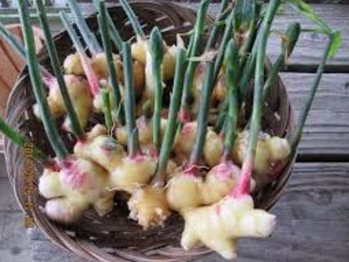 When choosing a pot for planting, note that ginger grows in breadth.This means that it is suitable shallow capacity, but with a flat bottom. From below it should be covered with a drainage layer, and it should be at least 3 cm. The plant does not like stagnant moisture, although it requires frequent watering.
When choosing a pot for planting, note that ginger grows in breadth.This means that it is suitable shallow capacity, but with a flat bottom. From below it should be covered with a drainage layer, and it should be at least 3 cm. The plant does not like stagnant moisture, although it requires frequent watering.
What should be the soil for planting
Knowing that the plant is ginger, it is necessary to choose the right soil mixture for it. Some flower growers recommend taking leaf humus, sand and sod land for its preparation in equal proportions. Others claim that you can use any land for planting. The main thing is that it is not solid, but rather loose. In any case, it is recommended to mix it with fertilizer for root crops with high phosphorus content before planting.
Did you know? Previously, on gulf ships, ginger was grown in pots and used as food. So sailors fled from scurvy and other diseases. And the ancient Greeks valued the plant for a beautiful light yellow flower with a purple border.
What should be the place of growing ginger
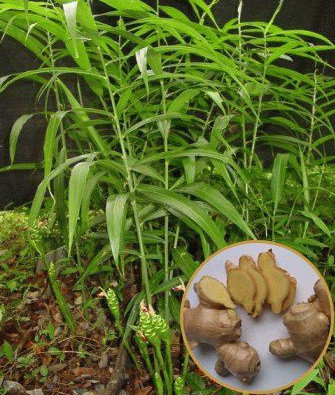 Under natural conditions, the growth of ginger takes place in warm conditions with a lot of light. If you plant it on the plot, pick up a place with high humidity, shaded, but well lit.You can land on the open sunny area, but in the middle of the day you need to plant a pritenyat. Ginger likes a lot of diffused light, but does not tolerate direct sunlight. The ideal place for its cultivation is the greenhouse.
Under natural conditions, the growth of ginger takes place in warm conditions with a lot of light. If you plant it on the plot, pick up a place with high humidity, shaded, but well lit.You can land on the open sunny area, but in the middle of the day you need to plant a pritenyat. Ginger likes a lot of diffused light, but does not tolerate direct sunlight. The ideal place for its cultivation is the greenhouse.
Another question is how to plant ginger at home. In this case, he can be settled on a balcony or loggia, he will feel well in the summer on terraces. But in this case it is necessary to ensure that the rays of the sun do not burn it.
Ginger grows in its natural habitat all year round, periodically releasing new flowers. Therefore, there is no special time frame for its landing. But if you want to grow ginger root in our strip, you need to know when and how to plant a plant in order to receive flowers or new tubers in the summer.
Planting dates ginger
In our region, crops are harvested in the fall. As the root grows and gains strength for at least six months, the best time for its planting will be the winter months.
How to choose and prepare ginger for planting
 In order to succeed in the cultivation of ginger, it is important to select the planting material from the very beginning. You can buy it in any supermarket, the choice of the root must be approached carefully. It should have a smooth skin without damage, traces of rot or freezing. It is advisable that it is not very dry. Although some experts say that after soaking the root in warm water, this is no longer a problem.
In order to succeed in the cultivation of ginger, it is important to select the planting material from the very beginning. You can buy it in any supermarket, the choice of the root must be approached carefully. It should have a smooth skin without damage, traces of rot or freezing. It is advisable that it is not very dry. Although some experts say that after soaking the root in warm water, this is no longer a problem.
The main thing is to have shoot buds on it.In their absence, the question of how to grow ginger will become irrelevant - the root simply does not germinate. In fact, the root for planting is prepared by analogy with potato tubers. It should be cut so that each share had at least two such kidneys. Slices must be treated with activated charcoal, a solution of potassium permanganate or hardwood coal. Some gardeners find themselves dividing, submerging the root in water, leaving a small part of it on the surface.
Before planting, it is advisable to prepare the root for planting, so that an awakened tuber is planted in the ground. This will increase the chances of success and accelerate the germination of the plant. To do this, the tuber is dipped for two to three hours in warm water, but do not forget about a large amount of light.
Planting ginger at home
So, with the question of whether it is possible to plant ginger at home, we figured it out. Now let's figure out how to do it right.
In the prepared substrate, the root is immersed with the eyes up to a depth of 3 cm. After that, it should be poured abundantly with water and put in a dry place, ensuring a temperature of about 15 ° C. Sprouts should appear in about two weeks.
How to care for ginger in a pot
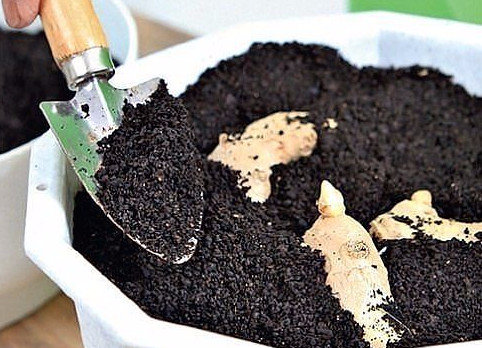 When the first shoots appear, it is necessary to proceed to the following rules for growing the plant. Having studied the ginger plant and everything about it, you should remember that he loves moisture, warmth and a lot of light.Accordingly, it should be placed in a penumbra in a warm place and organize frequent watering. At this stage of the growing season, it is important to ensure that the air temperature does not fall below 18 ° C, otherwise the root will go into “hibernation mode” and it will be difficult to reawaken it. The optimum temperature for normal plant development is 25 ° C.
When the first shoots appear, it is necessary to proceed to the following rules for growing the plant. Having studied the ginger plant and everything about it, you should remember that he loves moisture, warmth and a lot of light.Accordingly, it should be placed in a penumbra in a warm place and organize frequent watering. At this stage of the growing season, it is important to ensure that the air temperature does not fall below 18 ° C, otherwise the root will go into “hibernation mode” and it will be difficult to reawaken it. The optimum temperature for normal plant development is 25 ° C.
Important! At home, when grown in a pot, ginger grows to 100 cm. All parts of the plant have a characteristic lemon scent.
How to water the plant
In the issue of watering the main thing is not to overdry the soil in which ginger grows, otherwise the plant will die. But at the same time, excess moisture is also destructive for him - the root simply rot. Therefore, watering is carried out gradually, but often. After each such event, the soil must be loosened for better circulation of moisture. An excellent plant will feel if it is periodically sprayed with a spray bottle.
Features feeding ginger
 It is important to know not only how to plant ginger root, but also how to ensure its growth.To do this, it is recommended to conduct regular plant nutrition. Florists insist on regularity for normal vegetation of the plant. First advised to give organic fertilizers. At the stage of active growth it is necessary to use potash preparations, which will provide it with thick and beautiful greenery. When the plant is ready for flowering, it will require phosphate fertilizer.
It is important to know not only how to plant ginger root, but also how to ensure its growth.To do this, it is recommended to conduct regular plant nutrition. Florists insist on regularity for normal vegetation of the plant. First advised to give organic fertilizers. At the stage of active growth it is necessary to use potash preparations, which will provide it with thick and beautiful greenery. When the plant is ready for flowering, it will require phosphate fertilizer.
Important! In our strip and Europe, ginger rarely blooms. But this can be achieved if all the conditions of its cultivation are precisely observed: adhere to high humidity, high temperatures and hide it from the direct rays of the sun. Then a flower of light yellow color with a purple edge will appear on a long basal stem. True, the first flowering can be expected only two or three years after planting.
Ginger harvesting and storage
The final stage of the cultivation of the plant becomes the harvest. If you figured out how to plant ginger at home, take care to properly collect and preserve the results of their work. To this end, they gradually begin to reduce watering in the autumn, so that by the middle of autumn all the stems and leaves have dried up. Then you can dig up the root and prepare for storage.
![]() To do this, it should be cleaned from the ground, if necessary, wash and let dry in a fairly warm and well-ventilated room. Then it is sent for storage in a dark dry place with a temperature of not more than 4 ° C. As a rule, it is a cellar. But you can store the harvest in the refrigerator, after wrapping it in parchment paper. Keep your roots dry. In the vegetable compartment of the refrigerator, it can be stored for about a month.
To do this, it should be cleaned from the ground, if necessary, wash and let dry in a fairly warm and well-ventilated room. Then it is sent for storage in a dark dry place with a temperature of not more than 4 ° C. As a rule, it is a cellar. But you can store the harvest in the refrigerator, after wrapping it in parchment paper. Keep your roots dry. In the vegetable compartment of the refrigerator, it can be stored for about a month.
You can meet the advice to freeze the root and store it in the freezer. Of course, it is possible to follow him, but remember that at the same time the plant will lose most of its useful properties. You will have only spicy seasoning, which will give a pleasant taste to the dishes, but not a healing plant.
Important! Dried ginger has a sharper taste and a harsh aroma.
Ginger root for storage can be soaked in water. To do this, fresh tubers are well cleaned, poured boiled water and put in the refrigerator. Keeping its taste and medicinal qualities, in this form it can be stored for about a month. You can pre-grind it. In this case, ginger is stored in a sealed package at a temperature not higher than 35 ° C.
Surprisingly, ginger can be grown independently and in our latitudes. Even if the climate in your area is far from tropical, you can always plant a potted plant in your apartment. It is only important to provide him enough light, moisture and heat. Harvest can be collected and stored up to six months.
Was this article helpful?
Well no
Ginger is firmly entering our lives, in our kitchens, so the question of whether it is possible to grow ginger in the country, in the garden, on the balcony in difficult climatic conditions is becoming increasingly common.
Of course, a full-fledged high plant with a strong root system, for example, like growing corn, cannot be grown outside, but at home, on a windowsill or in a greenhouse, it is quite possible. As a result proper fit and care you can get an elegant exotic indoor plant, with unusual flowers, vaguely reminiscent of orchid flowers. The tall, long stem of ginger resembles the stalks of bamboo, adorned with long oblong leaves of rich green color. In order for this graceful, beautiful and also useful plant to appear, it is necessary to assimilate the proper cultivation of ginger at home in your home. To do this, first of all you need to choose the right ginger root. It should be young, dense, smooth, not have painful formations. It should also not have too many fibers, since their presence indicates a significant age of the plant. If you select a middle-aged ginger growing it will not bring results.
On a ginger root suitable for cultivation, there should be at least two three buds, which very quickly give full processes. Ginger cultivation of which can be carried out by seeds, it is better to grow in a vegetative way, because in this case there is a high probability that on your window-sill you will grow real ginger yourself. Growing ginger at home: planting and care. Choosing a root for planting is a guarantee that a grown plant will delight you with its elegant look, beautiful flowers and well developed roots that can be eaten and used as a healing tool. However, the success of growing ginger depends not only on the choice of the root. It is necessary to plant it properly and carry out proper care. Roots should be planted buds up, lightly sprinkled with fertile soil, rich in trace elements. Ginger cultivation at home requires a room where it is light and warm, since such conditions are as close to natural as possible, because India is the birthplace of ginger. Ginger, like a persimmon, the cultivation of which, perhaps at home, does not tolerate drought, so the soil should always be wet, but it should not be poured, it is also destructive for a capricious plant. Stagnant water should also be avoided, so there should be drainage in the plant container. Ginger cultivation of which is carried out according to the rules, even at home can reach a height of more than a meter.
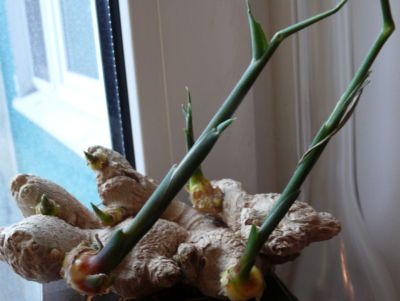
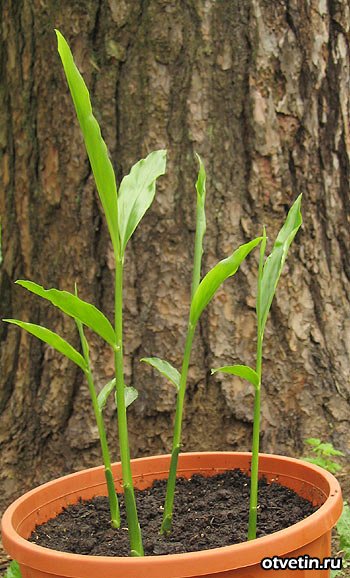
Ginger does not require any special care, however there are a few rules to follow:
1) Never pour water over ginger. He does not tolerate excessive watering. Therefore, the drainage for ginger should be quite voluminous. Best of all, the soil is always a little wet, so just check your pet every day and add a little water as the ground dries.
2) Ginger does not like cold. Nevertheless, it should be borne in mind that this plant came to us from their warm countries, and therefore it is accustomed to live in a warm climate. Therefore, it is advised to plant it in the spring, so that the ginger will spend most of its cultivation in close climatic conditions.
3) Do not put ginger under the direct rays of the sun. Despite the love of this plant for heat and light, yet do not expose it to direct sunlight. Otherwise, the thin stalks of ginger can burn, and not having time to fully enjoy life.
Before planting in the ground ginger root must be awakened. To do this, it is immersed in a warm solution of potassium permanganate and kept in it for about several hours. Then placed in a plastic bag until eyes appear, like in potatoes. When the eyes are well naklyunutsya ginger rhizome divided into parts. At least one well-developed kidney must be present on each part. The rhizome division is powdered with charcoal and dried for 15 minutes. Delenki planted in shallow, wide tanks with good drainage, consisting of sand and pebbles and filled with fertile soil. The soil can be composed independently of sod land, humus and sand in the ratio of 1: 1: 1/2. The spine is placed horizontally, with a splayed kidney up and covered with a layer of earth in 2 cm. Water it plentifully and regularly, preventing the soil from drying.
The first shoots appear in 1-2 months. In summer, with good hot weather, pots of ginger can be taken out into the open air. With optimal conditions content shoot height can reach 1 meter. In autumn, when the shoots die off, the rhizome needs to be dug, cleaned from the ground and stored in a dry place. Some of the roots can be taken for use in food or for treatment. Save another part until the next season and plant in the same way.
Fresh ginger rhizome can be stored on the bottom shelf in the refrigerator for about a month, and dried and crushed - up to 4 months.
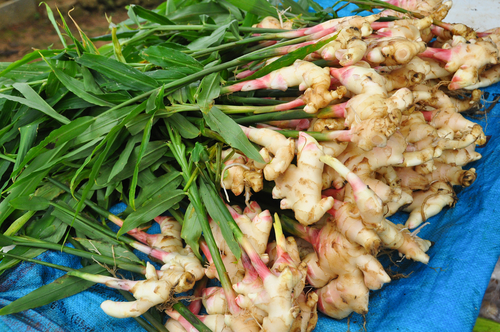
If you decide to grow ginger at home, then choose healthy fresh roots, not dried and without mechanical damage, preferably with points of future growth, the so-called "eyes".
The root should be cut into pieces (about 5 cm approximately), so that each part contains such “eyes”. Plant these pieces in the ground at a depth of 3 cm. Place the pot in a warm and bright place. The soil should be acidic, loose and well hydrated.
In the spring, the roots sprout faster than in the autumn-winter period. When young shoots appear, young shoots are planted in different pots.
In the summer, the plant should be sprayed with warm water often, it should be well to field. At home, ginger grows to 90 cm.
In the summer, the plant will appear flowers. The root ripens 10 months after planting. It is during this period that the plant enters rest mode, the green begins to turn yellow and die off. It can be cut, and the roots extracted and used for food.
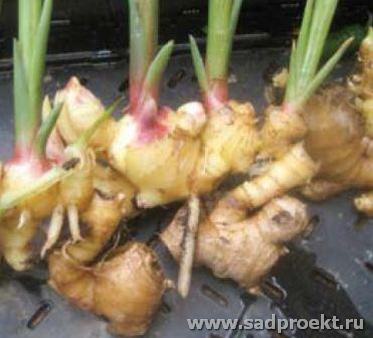
The root system of ginger, in nature, is located horizontally. Likewise, it is laid, kidney up (if any) in flower pots. Then the root is covered with a layer of soil and moistened.
With proper care and the selection of planting material ginger springs for six weeks. If possible, it is better if this period coincides with the onset of spring, which will provoke more active growth.
In the natural environment, ginger, like bamboo, does not tolerate frost and shade. Therefore, a place to grow ginger at home, you must choose a light and warm. The optimum average temperature should be 20-25 ° C.
Completing ginger in winter is not necessary, since, unlike fruit trees, it does not require ripening of the crop, but rest for a more complete development of the root system will be completely superfluous.
Watering ginger perform as the soil dries, at the root. Humidity is quite important for ginger. Therefore, they often moisten the foliage, drip irrigation or spraying with warm water.
After six months of growth, under good conditions, root system will be developed enough to get a harvest.
Going into the store, we see a huge amount of overseas fruits and vegetables. They are on sale all year round. They are most often brought from another state, from the other end of the world. To bring them to the consumer fresh is impossible. And so you want fresh! Let's try to grow exotics at home. Let's start with ginger. It is simple, interesting and useful.
In what form is ginger in stores? Semi-dry, germinated, very unattractive, but very expensive! Plant it at home and harvest. You can get a decent harvest if you create ginger growth conditions, like in your home country: warm, light and humid.
If you are going to grow this plant at home, you need to solve two questions for yourself, the answer to which all other actions depend on: will we grow ginger to get root crops or flowers, will it grow only at home or will it move to the garden outdoors in summer?
Ginger came to us from the rainforests of South Asia. Have this perennial herb plant very valuable, fragrant rootdeground, very similar to root and iris, the same thickened and branched.
Stems resembling sedge grow to a meter and a half in height, and twenty-centimeter leaves tightly cover the shoot. With good care on the plantings of ginger appear very beautiful, bright, unusual shaped flowers.
On industrial landings ginger root do not allow flowering, and when growing for yourself to admire such a miracle is very nice.
The complete development cycle of the root is about 8 to 9 months. If there are plans to get a harvest of ginger in the open air, then it is necessary to plant it in domestic containers in winter, so that it can mature before it starts to freeze.
Let's start by choosing the root.
How to choose a ginger root for planting
Selected root crops should be smooth, elastic with live buds, eyes. Planting material is cut into separate parts, 5-8 cm in size, so that each has at least one peephole.

In order to keep ginger for a long time and not to germinate, it is treated with special chemicals that prevent the growth of greenery at root-tubers before transportation.
Training
Remove traces of these substances and accelerate the germination of buds by soaking the planting material in warm water for up to 2 days. Means can be added to the water to kill the infection on the surface of the tuber. This may be potassium permanganate, a solution of soda (1 tsp in a glass of water) or a solution of Fitosporin.
Disinfected ginger can be planted in the soil. This plant roots do not go deep into the soil, which means that the capacity for planting it needs a wide and shallow. Drainage at the bottom is required. Its thickness must be at least 2 cm.
Next, pour nutrient soil. In this quality, suitable light garden soil or universal soil for flowers. You can mix garden soil with wood ash or charcoal. Such a mixture will prevent the spread of root rot.
Landing

Soaked roots are planted in the resulting soil mixture. It is necessary to strictly monitor that the kidneys are directed upwards. Planting material is filled with soil no thicker than 2-3 cm, and we leave as much to the edge of the planting capacity. The larger the area of the landing box, the more roots can be planted in it. Landing is completed by irrigation with warm water.
There is another way to germinate ginger.
Root soak

A rootknot placed on a thin rod is suspended above a container of water in such a way that it slightly touches the surface of the water. Before the appearance of the roots follow the water level. Tubers, with roots that appear, are planted as usual.
Shoots
At temperatures below + 25 ° C and high humidity, at least two weeks pass before the first shoots appear. In terms of growth, close to the native tropics, away from the cold and drafts, ginger grows very quickly. At lower temperatures, the shoots turn yellow and stop growing.

The question of watering is very important. Until the appearance of sprouts, the soil is kept moderately wet. With increasing green mass watered more often. The soil in the tank should always be wet.
It is necessary to water with warm and soft water. The higher the ambient temperature, the more often watering.
With a cold snap, the frequency of watering is reduced. Useful spraying.
Sustainable heat will allow ginger plants to land in the open air or in the greenhouse. On industrial plantations, planting is carried out according to such schemes as 40 * 40 or 35 * 60 cm. The place must be well lit by the sun and closed from the winds. In the midday hours openwork shading is desirable.
Grown up seedlings - care

Growing ginger in the open air or in the greenhouse should be aware of the timely watering. Maintain the necessary moisture content of soil and air is necessary throughout the growing season.
It is very important to obtain a high yield of roots make the necessary fertilizers. It should be organic and mineral supplements, but it is better if they are in liquid form. Bring them alternately every two weeks. You can use and ready-made forms intended for ornamental plants, in accordance with the recommendation on the package.
Fertilizing planting, you need to remember that nitrogen increases the growth of green mass, potash fertilizers stimulate budding, phosphorus increases the crop root crops. To reduce the yield of tubers will help reduce watering a month before the wilting of the leaves. In this case, the nutrients from the leaves pass the tubers, increasing their volume.
Harvesting
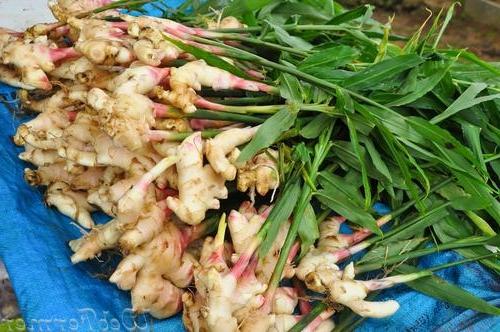
In September, ginger tops begin to turn yellow, dry and fall apart in different directions. This serves as a signal that the harvest period is appropriate and that it is necessary to reduce, and soon stop, watering. Rhizomes are removed from the soil, shaken off the soil, cut off small roots and dried in the sun for several days.
Store the harvest should be at a temperature not lower than 2-4 degrees Celsius. As an alternative to the cellar, a refrigerator is suitable, a vegetable compartment where the harvest can be removed in a paper bag.
Bloom
![]()
Growing ginger in the room can be for unusual colors. In order to see such a miracle it is necessary to limit the landing capacity. Lack of space in the pot stimulates ginger to tab flower buds. A ginger plant grown at home from planting material purchased in the vegetable department of a supermarket can bloom only two years after planting.
Since the beginning of autumn, ginger grown in a pot for flowers, is brought into the room. Digging root is not necessary. In one pot the plant can live for several years. In winter, watering is reduced to the limit. It is only necessary to maintain the soil in a slightly damp state. With the onset of spring watering increase, begin to add fertilizer to flowering plants, stimulating the growth of buds.
An ecologically pure product grown at home can be used both for culinary purposes to make a fragrant warming drink made from ginger or marinate it for future use, as well as for medical purposes.
Ginger root is an aromatic spice that has medicinal properties and is used in cooking and medicine. The plant itself is sometimes used as an ornamental culture, which is grown in pots and decorates the interior of the house. If you wish, you can grow ginger yourself, because there is nothing difficult about it. How to grow ginger, we will discuss in this article.
Ginger is a perennial crop from the ginger family and is a rhizomatous plant that lives in a tropical climate. In appearance, ginger resembles a low shrub, although it is considered a grassy crop. South Asia is home to this spice, but the plant is currently widespread in Australia, India, China, Indonesia, Jamaica and Barbados, as well as in West African countries. The ginger plant has long oblong leaves, some of them are folded into thin tubules and mimic the stems. All parts of the culture, both aboveground and underground, have a pleasant aroma, something reminiscent of the smell of lemon. Ginger root also has a sharp taste and has a warming effect on the body. Preparing ginger for plantingFor planting culture most often use rhizome. It is believed that ginger can be propagated by the seed method, but in the conditions of our country such a method is practically impracticable. In addition, vegetative reproduction provides a great guarantee that the new plant will take root in the soil. To plant ginger in your plot or at home in a flower pot, you should buy it in a store or on the market fresh root. Consider that it is young roots that are suitable for breeding a culture. Determining them in appearance is not difficult: they have a smooth, smooth surface and a pleasant light golden hue. Ensure that the planting material is not damaged and does not look wrinkled and sluggish. Before you grow ginger from the root, you should prepare planting material. Root should be immersed in a little warm water and leave it there for at least 24 hours. During this time, the buds, from which new sprouts will later hatch, will have time to swell. It should be noted that planting the whole root does not make sense, you can divide it into several parts and grow 3-4 plants or even more. The most important thing is that the fragment of the root that you plant should have several buds on it. If you cut the ginger into several parts, all the cutting sites must be treated with charcoal or ash to avoid the development of diseases and rot in the damaged areas.
Features of growing ginger in the open fieldThe choice of the place and time of planting cultureIn the southern countries, where ginger is grown for industrial purposes, the time of its development from the moment of planting to the digging up of roots is about 6-12 months. In Russia, the period of cultivation of culture ranges from 8 to 9 months. The roots of the plant are planted for sprouting seedlings around January or February, and in the spring, from April to May, the culture is transplanted to the garden bed. It is desirable that the open soil was protected by a film cover. As for the landing site, ginger prefers sunny areas, because it is a southern thermophilic plant. However, it is also not recommended to plant it under the scorching sun, it is desirable that a certain part of the day on the garden with ginger should be slightly shaded. Ginger also does not like a strong wind, so make sure that the area is not much blown out and, if necessary, provide additional windscreen to the plant. Since the climate of our country is rather severe for southern plants, it is recommended that ginger be grown not on open beds, and in greenhouses or in greenhouses. In addition, such designs allow you to create the most suitable conditions for the culture. In the event that ginger is diluted as an indoor plant and grows in flower pots, the containers can be taken out in the open air for summer or placed in a greenhouse.
Preparing the soil for gingerWhen growing ginger in the country should properly prepare the soil for culture. The plant loves a fertile, nutritious and light soil, which is well penetrated by air and moisture. It is important not to forget about the drainage, which will remove excess water and not let the roots rot. To prepare a suitable soil composition for growing ginger, mix 1 part of sod land with 2 parts of leaf humus and 1 part of fine river sand. The depth of the pit for planting ginger should be about 20 cm. When digging it up, do not forget to drain immediately. To do this, pour 2 cm of fine gravel at the bottom of the dimple, cover it with 2 cm of sand, and then plant the plant, filling the hole with previously prepared soil mixture.
Planting Ginger BedAround the month of April, the prepared parts of ginger roots can be planted on the site. As we said earlier, the ground as far as possible should be protected from wind and cold, as well as from the scorching sun. To deepen the roots of the plant should be about 2 cm, in addition, the soil before planting should be sufficiently moist. Approximately in 1-1,5 months the culture will give the first shoots. It is worth noting that ginger is growing quite rapidly and is actively increasing its green mass, therefore it is important to ensure timely and abundant watering for the plant. Constantly check the soil in the place where the culture grows, the land there should not be too dry. In addition to irrigation, the soil also needs loosening, which should be carried out the next day after irrigation. Loosening will make the soil porous, with the result that enough oxygen will get to the roots of the plant. Ginger can be grown in light shaded conditions, but you should not forget about regular watering. By the way, it is desirable to produce moisturizing not only at the root of the plant, but also to spray the leaves from a spray bottle. If the culture grows in a greenhouse, you need to monitor the maintenance of air humidity at the proper level. Irrigation of ginger is desirable in the evening hours, especially if it grows in a sunny place. Water, falling on the leaves, acts like a lens, and the sun's rays in this case can leave burns on the foliage.
Ginger fertilizerAn important condition for the cultivation of ginger are timely feeding. This culture responds very well to fertilizers, which should be applied to the soil once every 10 days, starting from the time that ginger germinates. In the first months of development, the culture is fed with mullein, which is dissolved in water in a ratio of 1:10. Instead of mullein, you can use chicken droppings and nettle tincture, which should be alternated with each other. Around August, ginger is also fertilized with potash, which contributes to the intensive development of the root system. If ginger is diluted in order to obtain rhizomes, it is not necessary to wait for its flowering. On the contrary, with the advent of buds, the development of tubers slows down. But if the culture is diluted only for decorative purposes, phosphate fertilizers can also be used as feedings.
Ginger: harvesting and storageGinger rhizomes begin to be dug out of the ground around the last days of September. The fact that the culture is ready to harvest, will indicate drooping and drying leaves. At this time, it is desirable to reduce the number of waterings, and spraying the leaves should stop altogether. As soon as the leaves turn yellow and fall off, remove the ginger tubers from the soil, scrape the ground off them, cut off thin adventitious roots, and then spread the tubers in the sun to dry slightly. Some of the crop is stored on next yearto grow a culture out of them again. The rest is used for medicinal or culinary purposes. Store ginger tubers preferably in a dry and cool place, for example, in the basement or in the cellar. Storage temperature should not exceed 2-4 ° C. Those who live in an apartment and do not have a basement, can wrap the roots in paper and put in storage in the refrigerator.
Growing ginger in a potGinger can be grown not only in the garden, but also at home, in a flower pot. It should be noted that such a plant is not always used for food, sometimes it is grown for decorative purposes. Ginger produces quite attractive large flowers with a rich pink hue. For those who want to grow ginger in a pot, here are a few recommendations:
Useful properties of gingerGinger has long been considered a plant that contributes to the prolongation of youth and beauty, as well as maintaining good health. The fact is that the rhizome of ginger is rich in various vitamins and other useful substances. For example, in this plant there are vitamins F, B2, C, B1. In addition to vitamins, in the root can be found magnesium, sodium, phosphorus, calcium, iron, zinc, potassium, as well as many amino acids. As a medicine, ginger is used to treat a variety of diseases. It is used for such purposes:
The advantage of this product is that it does not possess allergenic properties, therefore it can be used safely. To get the maximum benefit from ginger, it should be eaten fresh, because after heat treatment the plant loses some of its properties. The way ginger is used is not difficult. First you need to cut a suitable piece of the root, peel it, and then chop or grate. Ginger makes excellent tea or lemonade. To brew tea, peeled and grated root should be filled with boiling water and left for about 30 minutes to infuse. For added flavor, you can add lemon or mint to tea. Ginger is a popular ingredient in various marinades for meat and fish. In dried form, this root is added to hot first and second courses. The plant has found its application in the confectionery business, with the addition of this product baked cookies, make sweets, sweet syrups and jams. By the way, the taste of the finished dish will largely depend on the stage at which ginger was added. If the root is put at the very end of cooking, its aroma will be subtle, subtle. If you add a component at the beginning of preparation, the taste and smell of ginger will be more saturated. Determining at what stage of cooking to put in a dish of ginger, pay attention to the characteristics of the products from which you cook. If the aroma and taste of the main ingredients are not too expressive, add the root at the very end, so that it does not interrupt the smell of the dish.
Growing ginger. Video |

